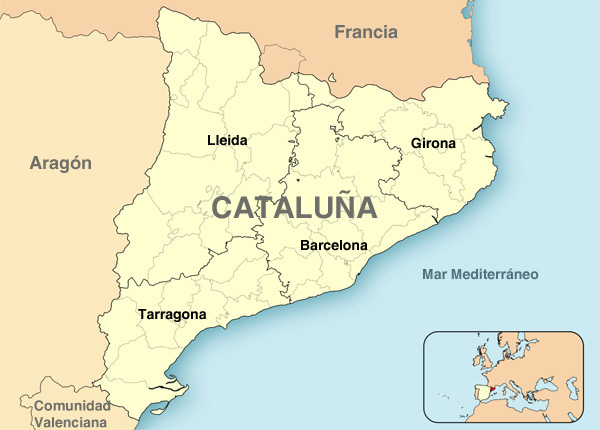The latest arrests in Spain of individuals presumed to be involved in activities related to jihadist terrorism occurred in Catalonia on Wednesday 8 April. They were part of a cell of followers of the self-proclaimed Islamic State (IS) that aimed to perpetrate an attack in Catalonia. It was Catalonia also, or more specifically Barcelona, that saw in 1995 the first arrest in Spain of a member of one of the terrorist organisations linked to the jihadist phenomenon, the Algerian Islamic Armed Group (Groupe Islamique Armé, GIA), at that time closely linked to al-Qaeda.
Of the total number of individuals sentenced for jihadist-related terrorist criminal offences between 1996 and 2013, 33.3% were arrested in Catalonia –up to 28.6% in the province of Barcelona– and 30.6% were resident in that Autonomous Community –again, similarly, up to 23.5% in the province of Barcelona–. But these percentages are significantly higher when considering those sentenced who were arrested between 2004 and 2012, rising to respectively 37.5% and 35.7%. Thus, four out of every 10 individuals sentenced for jihadist terrorist activities in Spain during the period were located in Catalonia.
Catalonia was also where the Egyptian Mohamed Atta –the ringleader of the suicide terrorists responsible for the attacks of 11 September 2001 in New York and Washington– and the Yemenite Ramzi Binalshibh –who liaised between the September 11 cell and the al-Qaeda leadership– met two months before putting their plans into action in order to work out final details. Their meeting was held between the towns of Salou and Cambrils in the Catalonian province of Tarragona, very close to the home of another al-Qaeda member, an Algerian who was in touch with the most important members of the so-called Abu Dahdah cell that the terrorist organisation had established in Spain in 1994.
A jihadist cell linked to al-Qaeda was broken up as a result of the antiterrorist operation carried out in Catalonia in January 2003. Its members were in possession of mobile phones that were identical to those used a little more than a year later in the 11 March terrorist attacks in Madrid and had been altered in a similar way. Furthermore, those who had fled after 11-M to Iraq passed through Santa Coloma de Gramanet, a town in the province of Barcelona where members of the Moroccan Islamic Combattant Group (Groupe Islamique Combattant Marocain, GICM) were active. The latter were linked to facilitators of another jihadist organisation associated to al-Qaeda’s Iraqi branch, Ansar al-Islam (AI).
At the time, Catalonia had more than 100 Islamic places of worship, and that number has now doubled. In no less than a quarter of them the presence was detected of extremists related to jihadist organisations such as –in addition to those mentioned above– the Salafist Group for Preaching and Combat(GSPC) as well as of numerous adepts of Hizb ut Tahir and of Tabligh Jamaat communities, which are non-violent fundamentalist entities but that, similarly to fundamentalist Salafism, promote beliefs that are incompatible with the democratic values of an open society. In Catalonia there are around 50 Salafist worship places, half of all those currently in existence in Spain.
Barcelona and not Madrid was the target for an 11-M-style repeat attack in January 2008. Ten Pakistani-born individuals, seven of them resident in Barcelona and one a naturalised Spanish citizen, in addition to an Indian national, were sentenced for being party to a planned, most likely suicide bomb attack, thwarted at an early stage of preparation, against the Barcelona metro. The plan had a direct link to Therik e Taliban Pakistan (TTP), one of the main associate organisations of al-Qaeda. Prominent senior members of the latter received funds from another jihadist cell broken up by the authorities in Catalonia in September 2004.
Since 2013, with the start in Spain of the antiterrorist operations aimed at dismantling networks connected to jihadist organisations based in Syria and Iraq, 35.3% of those suspected to be involved in them have been arrested in Catalonia, the Autonomous Community in which 39.5% of them were resident, and up to 31.8% and 36% of the total, respectively, in the province of Barcelona. These percentages are in line with the upward trend noted for the past decade that indicate that four out of every 10 individuals convicted for jihadist-related terrorist activities were linked to Catalonia, especially Barcelona and its metropolitan area.
Overall, Catalonia is over-represented in these figures, considering the number of immigrants from countries with Muslim majorities and their descendants in the Autonomous Community of Catalonia –mainly Moroccans and Pakistanis– since they account for no more than 26% of the total in Spain. The figures particularly over-represent the province of Barcelona that, although the home to the largest number of individuals of such an origin, accounts for only 16% of the Spanish total. Furthermore, in the Catalan case, radicalisation processes have begun to affect other segments of society, with a striking emergence of jihadist converts.




